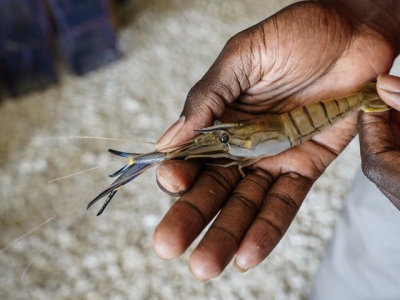Freshwater shrimp farming would help control deadly parasitic disease

River shrimp, like this Macrobrachium raised in a local hatchery in the Senegal River basin, can consume a dozen or more snails per day. A team led by University of California, Berkeley, scientists, has shown how communities can harness freshwater prawn's voracious appetite for snails to battle the parasite that causes schistosomiasis, while still making money selling the prawns for food. Credit: Hilary Duff of the Planetary Health Alliance
Freshwater shrimp (river prawns) consume snails that transmit the parasite that causes schistosomiasis, so increased farming would reduce the spread of the deadly parasitic disease, according to a study from the University of California, Berkeley.
The study provides a roadmap for how entrepreneurs can harness freshwater shrimp's voracious appetite for snails to reduce the transmission of these parasites, also known as “blood flukes".
“River prawns are common aquaculture products in settings around the world, and we know these organisms are voracious predators of the snails that transmit schistosomiasis,” said the university's Christopher Hoover, a doctoral student who led the study. “What has not been clear is if we could marry the economic benefits of prawn aquaculture with the disease-control activity of the prawns.”
As the shrimp grow, they feed on the snails that carry the schistosome parasite. The parasite is incapable of infecting the shrimp themselves, and schistosomiasis is not transmitted via ingestion, so raising, harvesting and consuming the shrimp cannot pass along the disease.
The researchers used economic and epidemiologic modeling to pinpoint the optimal points at which to stock and harvest the prawns, with the joint goals of reducing schistosomiasis transmission and generating revenue from selling harvested prawns.
“Our results show that there are highly beneficial configurations of prawn aquaculture systems that minimize tradeoffs between generating revenue from harvesting prawns and reducing schistosomiasis transmission,” Hoover said. “We can design systems to maximize profit while having a substantial impact on disease reduction, potentially helping to lift populations out of poverty in emerging and developing economies.”
Schistosomiasis, also known as “snail fever", affects around 250 million people a year and kills as many as 200,000. The disease is primarily spread when people come in contact with contaminated water. While drugs are available to treat the disease, they’re not enough in some settings. Because drug treatments only address the human component of the parasite’s transmission cycle, people are left vulnerable to reinfection, even soon after treatment.
By acting on the environmental component of the transmission cycle -- the intermediate host snail population - shrimp-based interventions can complement drug treatment, yielding greater population benefits, according to the study.
The model showed that, to reduce parasite loads, introducing shrimp to infected waterways was comparable to the standard approach of widescale administration of schistosomiasis-fighting drugs, and that it could decrease the parasite burden to nearly zero after 10 years.
Shrimp may have environmental benefits, as well, including substituting for chemical pesticides to control snail populations and restoring native biodiversity in areas where native prawn species have been decimated by dams.
“This research contributes a new tool to our global efforts to combat schistosomiasis,” said the university's Justin Remais, co-senior author of the study. “Poverty and schistosomiasis are intrinsically linked, and transmission of the parasite is known to stunt growth and cognitive development in children and to prevent adults from working, reinforcing poverty.
By targeting transmission of the parasite itself, while also supporting a locally-sourced production system where economic benefits accrue to the community, this approach has great potential to supplement ongoing disease control campaigns that generally rely on drug treatment alone.”
Related news
 Hyper-drive: the pros and cons of intensive RAS production in the US
Hyper-drive: the pros and cons of intensive RAS production in the US The hyper-intensive production of tropical species might be a hard sell in the US, but a handful of companies have developed systems that have made successful
 Shrimp feed market demands spurring production equipment design
Shrimp feed market demands spurring production equipment design Clextral gave us the low down on fish and shrimp feed production trends behind extrusion equipment innovation at the Cologne feed processing show, VICTAM
 How a new breed of breeder is transforming US shrimp production
How a new breed of breeder is transforming US shrimp production How American Penaeid rose from the rubble of two hurricanes to create a new model for shrimp production in the US.